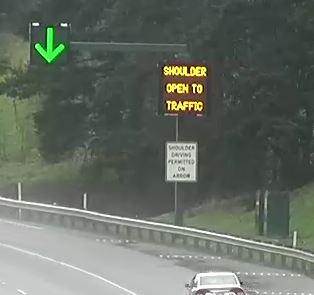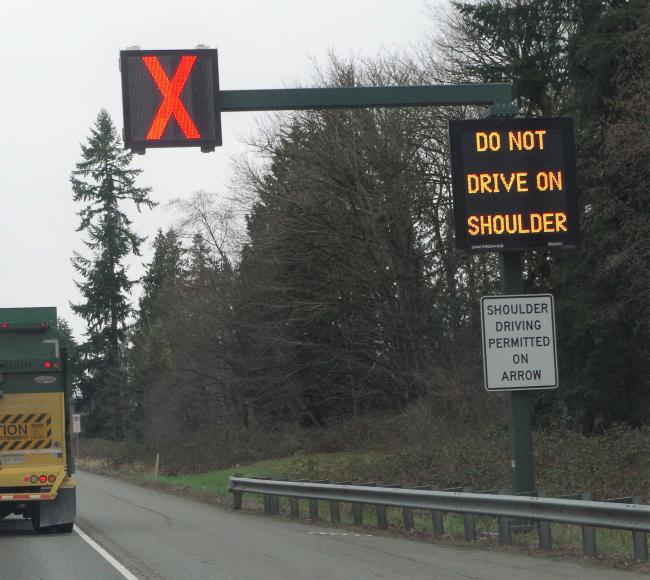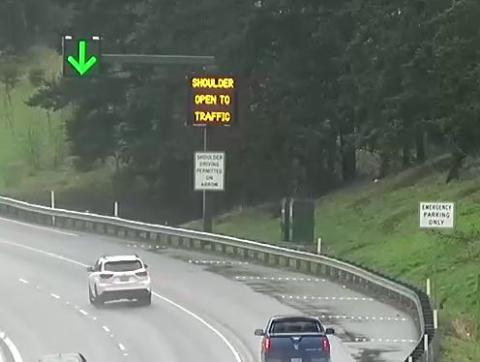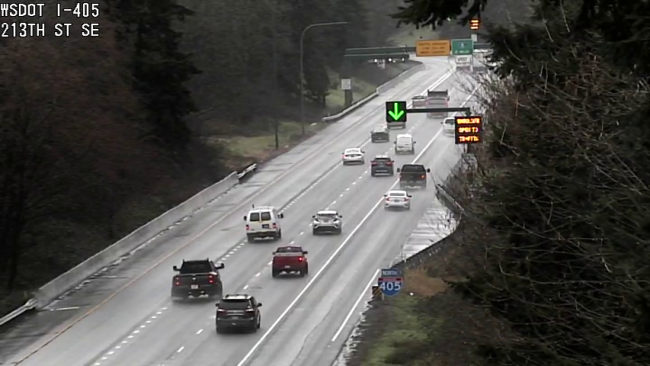Part-time shoulders
Sometimes a shoulder isn't just a shoulder, it's a travel lane. Learn about part-time shoulders and when and how to use them.

Part-time shoulders lanes allow vehicles to utilize the roadway shoulder as a lane under certain conditions. They are available for use as a regular driving lane during specific days and times, providing an additional lane during periods of heavy congestion. Some part-time shoulders are restricted to use only by certain vehicle types.
These special shoulder lanes are a new traffic management strategy being applied in specific areas as an alternative to highway widening, which can take longer to implement and require more physical space than may be available.
Careful consideration is given regarding where part-time shoulders are implemented - not all locations are appropriate or available. Shoulders must have the width, pavement depth, and other design elements necessary to accommodate the applicable vehicles, and the highway downstream must be able to handle the additional capacity.
Types
There are two basic types of peak-use shoulder lanes used in the state:
- Static: These lanes are open at specific times on specific days, as posted on the fixed signs.
- Dynamic: These lanes are open on an as-needed basis, and use electronic signs to display when the shoulder lane is open to traffic. The electronic signs use the standard symbols of a green down arrow for when they are open, and a red X for when they are closed.

Truck climbing shoulders are a type of static part-time shoulder where slower trucks use the shoulder to climb a steep upgrade, allowing other vehicles to pass them safely.
Restrictions
Part-time shoulders can be open to all vehicles, regardless of the number of occupants, or may be restricted to certain vehicle types or occupancies. Some of the typical part-time shoulder use cases include:
- Open to all vehicles
- Open to all vehicles except those over 10,000 GVW (buses exempt)
- Open to buses and HOV use only
- Open to buses only
- Open only to slow-moving trucks (truck climbing shoulders - rural highways with only one uphill lane)
Incidents
In the event of an emergency or blocking vehicle while the shoulder lane is open, the incident is treated the same as if it were in a typical traffic lane and the shoulder is closed until the incident is cleared. Where electronic signs are available, they will indicate that the lane is closed with the red X symbol. Dynamic part-time shoulders open to all vehicles or HOV traffic will normally have emergency pullout areas available to move disabled vehicles out of the shoulder lane (if possible).

Locations
Interstate 405, Snohomish County

- Northbound, from Highway 527 to Interstate 5
- Dynamic, using electronic signs
- Normally open during the afternoon weekday commute
Highway 2, Everett
- Eastbound, from Interstate 5 to Highway 204 (Hewitt Ave Trestle)
- Static, using fixed signs
- Open from 2 PM to 7 PM, Monday - Friday
Highway 14, Vancouver
- Westbound, from SE 164th Ave to Interstate 205
- Existing: Static signs for bus (transit) use only.
- Future: Dynamic, using electronic signs.
Currently, the Highway 14 part-time shoulder uses static signs and is only open to buses. An upcoming project will convert this to a dynamic part-time shoulder, which will allow for use by more vehicle types during peak hours and improve the off-ramps to northbound and southbound Interstate 205. Visit the project website for more information.
Slow down on ice and snow.
It's easier to skid or lose control traveling at higher speeds. Give yourself more time to stop.
Carry chains, practice installing them.
Winter conditions could mean chains are required on your route. Practice putting them on your vehicle ahead of time.
Pack your winter car kit.
Carry extra supplies like warm clothing, ice scraper and brush, jumper cables and other emergency items.
